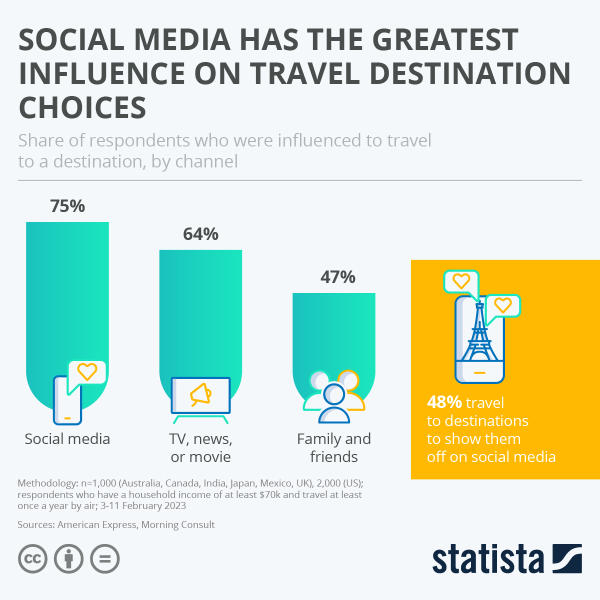“Trend” can be a dirty word. A noisy, flitting, vapid distraction clamoring for attention while offering nothing of real substance or impact.
But some trends present opportunities. They’re built on strong foundations and ripe with future implications.
In the ever-shifting landscape of destination marketing, it’s important to know which is which — and which you can trust to strengthen your strategies.
So, with the first quarter of 2024 in the rear-view mirror, let’s look at the trends shaping the year.
Immersive Technologies to Inspire Tourism
Travelers crave experiences, and you can deliver before they even step foot in your destination. Destinations are leveraging immersive technologies like virtual reality, augmented reality, and mixed reality to craft experiences that give both leisure and business travelers a taste of the exploration awaiting them.
Visit Albuquerque, for example, lets you soar among air balloons at the Albuquerque International Balloon Fiesta. Visit Irving, Texas, helps you explore the entertainment district. Visit Los Cabos helps visitors fall in love from afar — to the tune of a 300% increase in web sessions.

Generative AI Generates Excitement (and Concern)
Last year saw the birth, and subsequent gold rush, of new Artificial Intelligence (AI) startups and tools. We even featured it as a trend to watch coming into the year and covered the latest developments on the Layover Live podcast.
Well, 2024 is the year of mass adoption with 65% of destination marketers already using AI to aid their work (CrowdRiff).
It’s easy to see why.
At a high level, generative AI can launch content ideas for blog posts or social media campaigns, craft copy to speak to different demographics, fuel chatbots to provide a welcoming and convenient 24/7 helpdesk on your website, and so much more.
But DMOs also use it to save time in critical digital marketing work.
Just be careful, AI’s evolution hasn’t been without trials (literally). AI has become a helpful tool for DMO pros, but don’t forget how essential a human touch is before activating your results.
User-Generated Content Infuses Authenticity
Authenticity has never been more important in the tourism space (and, frankly, everywhere else as well). Visitors want to see a destination’s real personality. The one born from the unique experiences — and even more, unique people — that make it worth visiting.
But branded messaging can miss the mark. People just trust real people more than they do any brand.
So give them what they’re looking for. Give them user-generated content (UGC).
A recent study shows 62% of consumers think UGC is a “highly important” means to improve a brand’s authenticity. And 91% of those same responders noted it’s at least “moderately important” in the same context.
In their 2024 Trends Report, CrowdRiff found that “81% of destination marketers we surveyed have seen an increase in engagement on social media through UGC.”
That’s vital because social media influences more people to travel to a destination than any other medium, with 48% of those visiting a destination to show it off on social media (Statista).

Content is King. Personalization is Queen.
One-size-fits-all marketing is a thing of the past. Travelers today expect a customized approach, and convert at a higher rate when they get it. Let’s look at the numbers:
-
71% of consumers expect companies to deliver personalized interactions (McKinsey)
-
76% of consumers get frustrated when content isn’t personalized (McKinsey)
-
85% of companies feel they provide personalized experiences, but only 60% of customers agree (Segment)
-
Personalized CTAs outperform default versions by 202% (HubSpot)
-
Website personalization is used by 56% of companies (Statista)
So harness the full power of your content by personalizing the experience for your audience. Feed foodies a curated menu of blogs, listings, and food tours to satiate their appetite for culinary discovery — and deliver value for your partners.
Or perfect the planner experience by blending blogs that showcase exciting things to do, content to highlight your destination’s intellectual capital, an immersive virtual tour of your facilities, and a prominent request for proposal submission (RFP) opportunity.
Opportunities abound, and they’re more important than ever.
If you use Simpleview CMS, check out the dynamic content module to build your own custom web experiences for each of your personas.
Micro Influencers. Macro Results.
Influencer marketing has evolved. Oversaturation and increased costs have forced marketers to re-evaluate their strategies. But that doesn’t mean it’s slowing down — 69% of consumers still trust influencers, friends, and family over messaging coming directly from brands (Marketing Drive).
Instead, destination marketers are focusing on strategically selecting small influencers for lower-cost, high-ROI campaigns. Research shows that 70% of brands prefer working with nano (1,000-10,000 followers) and micro (10,000-100,000 followers) influencers compared to larger options in 2024 because of their cost-effective price points and higher engagement rates (Influencer Marketing Hub).
Where you deploy micro-influencers is equally important.
TikTok rose in prominence last year but has surged to become the premier channel for brands to deploy influencers in 2024.

Interestingly though, only 14% of marketers said TikTok drove the biggest influencer marketing ROI in 2023 compared to 30% who pointed to Instagram as the best platform for their ROI (Hubspot).
So tune into your audience and closely monitor your results to maximize your spending on the ideal channels.
Stay in the know.
Subscribe to the Simpleview newsletter to get the latest blog posts delivered straight to your inbox.
Sign up

